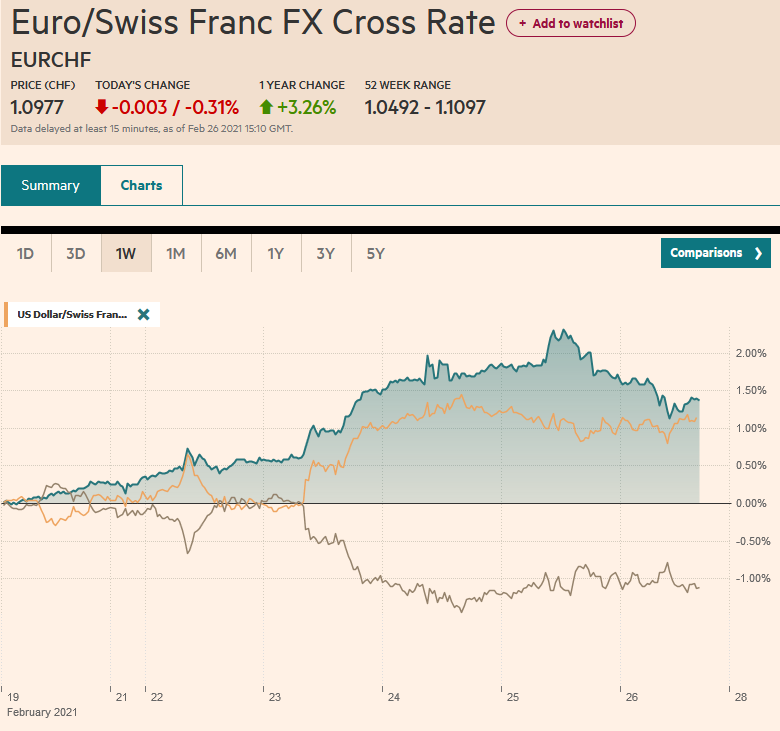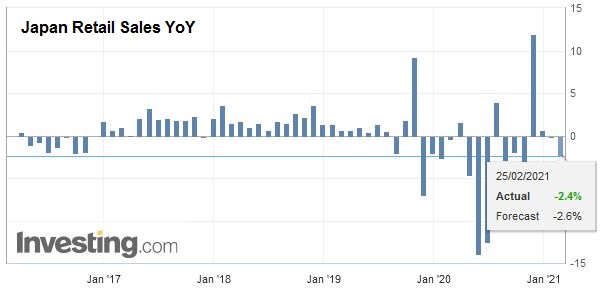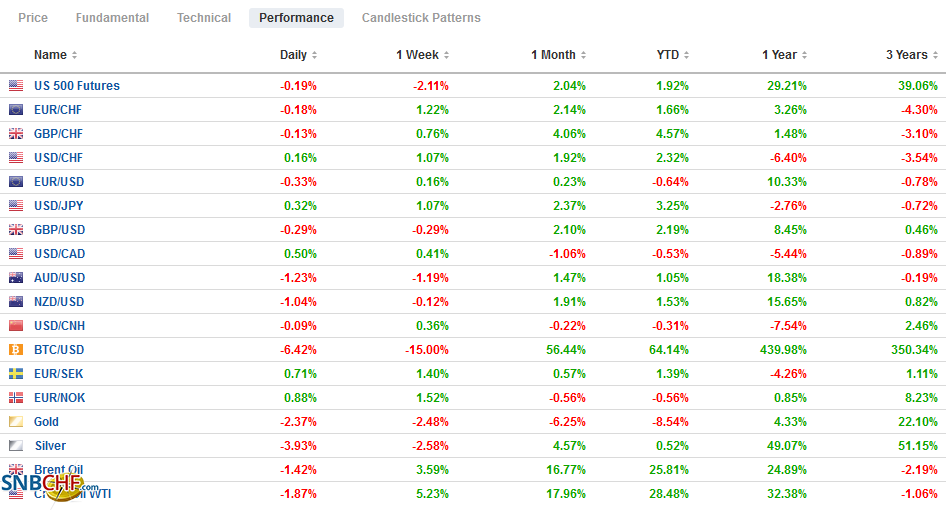Swiss FrancThe Euro has fallen by 0.31% to 1.0977 |
EUR/CHF and USD/CHF, February 26(see more posts on EUR/CHF, USD/CHF, ) Source: markets.ft.com - Click to enlarge |
| Overview: A poor seven-year note auction and ideas that the first Fed hike can come as early as the end of next year spurred a steep sell-off in bonds and equities. Technical factors like the triggering of stops losses, large selling in the futures market, which some also link to hedging of mortgage exposure (convexity hedging), also play a role. The abrupt shift in view helped gave the greenback support. Its recovery was especially pronounced against the high-flying dollar-bloc currencies and sterling. Even though US yields pulled back, the carnage spilled over into Asia Pacific trading, where most large markets were off 2%-4%. At the same time, some of the smaller bourses, such as Singapore, Malaysia, and Indonesia, held up considerably better. Europe’s Dow Jones Stoxx 600 is off around 0.65% in late morning turnover, and it is set to snap a three-week advance. US shares have stabilized at lower levels. The US 10-year yield, which hit 1.60% yesterday, is at 1.48%, and European benchmark yields are mostly 1-2 bp lower, though 10-year Gilt yields at 0.81% at new higher for the week. Follow-through dollar buying is evident today against most of the majors, and the Antipodeans, Scandis, and sterling are off 0.3%-0.5%, while the Swiss franc and yen are little changed. Emerging market currencies are mostly lower. This week’s loss in the JP Morgan Emerging Currency Index (2%) would the largest in more than four months. Gold fell to almost $1755, its lowest level since last July, and is around $1760 near midday in Europe. It is off about 1.4% this week. April WTI has consolidating below yesterday’s $63.80 high. It is in roughly a 50-cent range on either side of $63.00. It settled last week near $59.25, making it about a 6.25% advance this week. |
FX Performance, February 26 |
Asia PacificJapan reported better than expected January industrial production and retail sales figures. Industrial output rose 4.2% in the month. Bloomberg’s survey median was for a 3.8% gain. It appears exports may be playing a decisive role as domestic demand seems soft. It was the first gain in three months. Retail sales fell by 0.5%, less than half the decline expected. Tokyo’s February CPI ticked up, but both the headline and core rates stand at -0.3%. Separately, Japanese yields jumped, with the five-year yield rising to its highest level in 3 1/2 years (minus 2 bp) before slipping back to minus 6 bp. Japan’s 10-year yield reached 18 bp, its highest since 2016 and just shy of the 20 bp cap under the yield curve control program. It slipped back to 16 bp at the close. There is some speculation that the BOJ could widen the target band for the 10-year yield at next month’s meeting. |
Japan Retail Sales YoY, January 2021(see more posts on Japan Retail Sales, ) Source: investing.com - Click to enlarge |
The Reserve Banks of Australia and New Zealand are being challenged as well. The RBA bought government bonds in an unscheduled operation, and still, the 3-year yield still finished the week above the 10 bp target. The RBNZ Governor Orr said that including house prices into the central bank’s remit, which he had opposed, will not impact monetary policy. He reiterated that the central bank will provide a stimulus for a long-time. On the week, Australia’s 10-year yield surged 30 bp to 1.9%, while New Zealand’s 10-year yield rose 28 bp and is also near 1.90%. The two-year yields tell a different story. Australia’s two-year yield slipped 1.5 bp this week to 0.10%, while the New Zealand two-year yield rose 10 bp to 0.35%.
The yen was pulled in opposite directions by external market developments. The dramatic sell-off in equities is often associated with a stronger yen, while the jump in US yields is frequently linked to a weaker yen. The bond impulse won out, and the dollar reached JPY106.50, its highest level since last September. Nearby resistance is seen around JPY106.55 and then JPY107.00. A break of JPY105.85 would weaken the dollar’s technical tone. The Australian dollar staged a key reversal yesterday by making new highs for the move (~$0.8005) and then selling-off to close below Wednesday’s low (~$0.7895). Follow-through selling has pushed it to almost $0.7800 today. This corresponds to the (50%) retracement of the rally since the Aussie last dipped below $0.7600 on February 5. The next retracement level is near $0.7745. The 20-day moving average is a little higher (~$0.7760). China’s yuan has been remarkably stable. The dollar has mostly has remained in the same range seen on the first two trading days of the year (~CNY6.43-CNY6.5150). The dollar rose by less than 0.1% against the yuan this week. The PBOC fixed the dollar at CNY6.4713 today, which was a little firmer than expected. The yuan’s low volatility makes it attractive when constructing portfolios.
Europe
The rise in European rates clearly is a new challenge for the ECB. Europe’s recovery is lagging behind both Asia and the US. It is less equipped to cope with rising yields. The ECB may have to provide more support to the extent that rising yields weakens the recovery effort. One form that could take is a lower deposit rate (now at minus 50 bp). It is too early to argue this is needed, but it remains an option. The staff at next month’s ECB meeting is likely to reduce its forecast for near-term growth.
The economic highlight next week in the eurozone may not be so much the PMI, which the flash readings do an excellent job of anticipating but the February CPI. Today, both France and Spain reported their harmonized figures. France’s flat reading on the month translates to a 0.7% year-over-year increase, down from 0.8% in January. Both were a little stronger than expected. Spain’s CPI was weaker than expected. Prices fell 0.6% on the month. The market anticipated a 0.2% decline. The year-over-year rate fell to -0.1% from 0.4%. The median forecast was for an increase to 0.5%. The early call had been for the aggregate CPI (due March 2) which would increase to 1.1% from 0.9%.
The EU appears to be moving toward vaccine certificates. Officials seem rather lukewarm to the idea but fear that the likes of Apple and Google could move into the space. Meanwhile, a virtual G20 meeting will be held today. Italy has the presidency. Up for discussion is a new SDR allocation. Recall attempts to issue more SDRs last year were rebuffed. Italy is advocating a $500 bln issue. The last one during the Great Financial Crisis was for $250 bln. US Treasury Secretary Yellen is more supportive, but there is a catch. Without providing specifics, she suggested broad parameters are needed to boost transparency about how the reserves are used. The problem is that the SDRs are often used to service debt rather than domestic investment. China is the largest bilateral lender to many poor countries. A new SDR allotment would help China get repaid, but it also puts more yuan into central bank reserves, helping Beijing achieve another objective. SDRs are allocated on the basis of subscriptions to the IMF, which of course means that to ostensibly help poor countries, the rich countries get fed well too. The “parameters” that Yellen alluded to seem to violate the spirit if not the letter of the SDRs, which are to be unconditional and may appear to some as another attempt by the US to extend its control.
The euro peaked yesterday near $1.2245, its best level since January 8. It closed around $1.2175 and has been sold to about $1.2115 in the European morning. The $1.2100 area may offer initial support and this month’s trendline comes in near $1.2085. The euro finished last week by $1.2120. Although the euro has been trending higher, it has been alternating between weekly gains and losses since the middle of January. Recall that the week before (ending February 12), the euro also settled near $1.2120. Given the dramatic action in stocks and bonds, month-end adjustments are a wild card today. Sterling peaked in the middle of the week near $1.4240. It fell yesterday to $1.40, and today it tested $1.39. Today’s low corresponds to the (50%) retracement of this month’s rally (from the February 4 low below $1.36). The 20-day moving average is near $1.3865, and the (61.8%) retracement is closer to $1.3825.
America
The implied yield of the December 2022 Eurodollar futures contract rose to 50 bp yesterday (from 33 bp at the start of the week). This would be consistent with a 25 bp rate hike a year before the Fed has suggested it is likely to do so. Investors see the large fiscal stimulus and anticipate a booming economy. Some conclude this means a Fed hike is expected sooner than officials acknowledge. The contract is little changed today, ahead of the US session, implying a 44 bp yield. It was at 27 bp at the end of January. At the same time, the overnight repo rate traded down to minus 10 bp yesterday, reflecting the scramble for places to park funds in the pace of smaller T-bill issuance as the Treasury reduces its cash position.
The reconciliation process under which the stimulus plan can pass with a simple majority works requires that the components are only for fiscal policy. The Senate parliamentarian ruled that the minimum wage increase does not fit the requirement. Cutting taxes or boosting spending is actions that government takes. That is fiscal policy. The minimum wage is not seen as a fiscal issue. However, the US government is among the largest employers of minimum wage workers through contracts of vendors and clerks and maintenance at parks and museums, etc. There will be an attempt in the Senate to modify it to overcome the parliamentarian’s objections. The House of Representatives is expected to approve as early as today the stimulus measure, with the minimum wage increase.
Today’s economic calendar features the January personal income and consumption figures. Income will be boosted by the $600 checks from the government, while the surge in retail sales points to a strong gain in consumption after declining in November and December. The January deflators are likely to be little changed, around 1.4%. The Fed targets the headline rate at 2.0% but talks a great deal about the core rate. Canada reports raw material prices, which tend not to elicit a market response. Mexico reports its January trade balance. Economists look for a small deficit ($600 mln) after December’s $6.26 bln surplus. It will be the first deficit since last May. The trade deficit stood at $2.48 bln in January 2020.
The US dollar staged a key reversal against the Canadian dollar yesterday. It initially fell to about CAD1.2470, a new multiyear low, before rebounding with gusto through Wednesday’s high (~CAD1.26) and closed above it. Follow-though greenback buying sent it to CAD1.2650 today. Nearby resistance is seen in the CAD1.2670 area and then CAD1.2700 area, which also houses the 20-day moving average. The US dollar traded above MXN21.00 for the first time since early November yesterday and is consolidating around it today. The next key level is around MXN20.20, the 200-day moving average, which it has not traded above since last October. The peso had been falling out of favor in the face of rising US rates and government policies that alienate investors. The peso’s weakness also may hamper policymakers. Without much fiscal support, monetary policy has to bear the burden. Many expected a 25 bp cut next month, but Banxico may be reluctant if the currency continues to weaken.
Graphs and additional information on Swiss Franc by the snbchf team.
Full story here Are you the author? Previous post See more for Next postTags: #USD,Australia,Currency Movement,Featured,inflation,New Zealand,newsletter,SDR





























